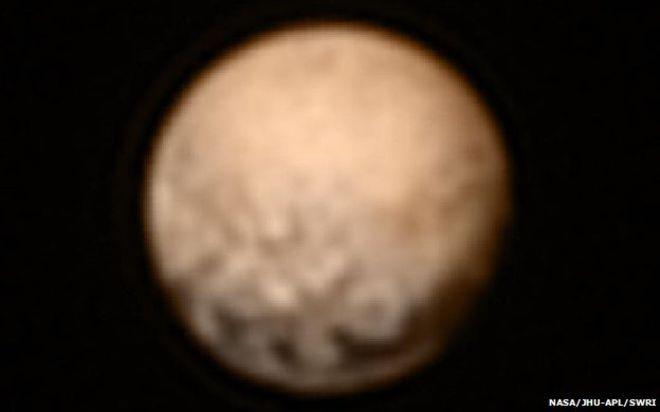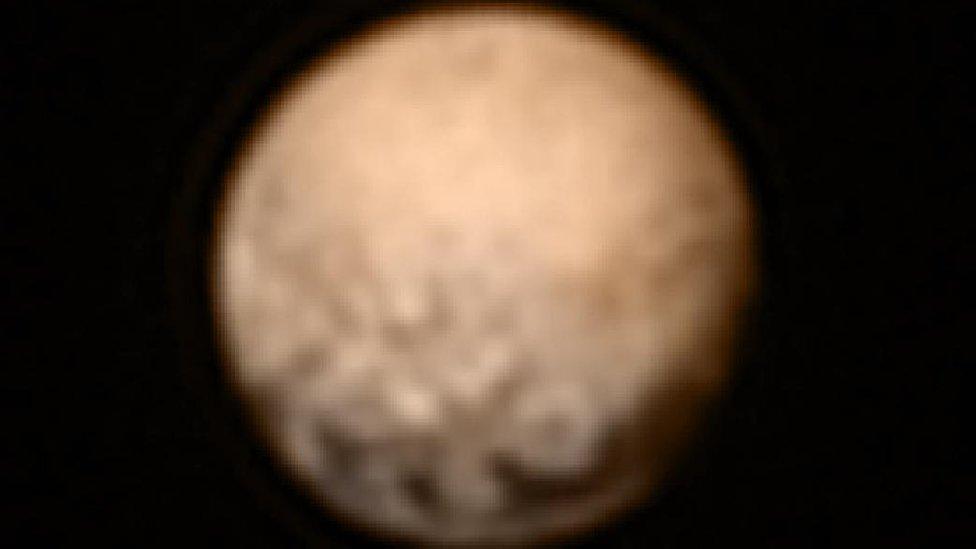What will Pluto mission discover?
- Published

Pluto is the last of the nine "classical" planets to be visited by a spacecraft
On 14 July, the New Horizons spacecraft will fly by Pluto. The distant object was downgraded from a planet to a dwarf planet in 2006, but that hasn't taken the shine off a mission which marks the beginning of a new frontier in exploration.
Why go to Pluto?
Pluto is the last of the nine "classical" planets to be visited by a space mission. Orbiting at an average of 5.9 billion km from the Sun, this tiny world appears banished, like the Roman god of the underworld whose name it bears.
But this enigmatic denizen of the icy outer reaches of the Sun's domain may have much to tell us. While the erstwhile planet and its remarkable moons hold many surprises, it may also give us a more complete appreciation of a completely unexplored region of our Solar System and yield new chapters in the story of how it unfolded.
Pluto was the last world to join the club of planets in our Solar System. In 1930, it appeared as a slow-moving speck in a series of telescope photographs. Over time, instruments have grown in power and scientists have learned more. But even when viewed through the Hubble Space Telescope, which has resolved distant galaxies, details of this icy outcast have been scant.
The best way to find out what a planet is like is to visit, which is exactly what New Horizons will do.
What does New Horizons hope to discover?

The spots are part of a dark band that wraps around much of Pluto's equatorial region
Until now, scientists have had few details about Pluto's surface. The New Horizons spacecraft will be less than 8,000 miles from it at closest approach. The photographs it takes will be the first to reveal whether there are rising peaks and deep troughs or a more undulating topography.
New Horizons has already seen signs of a polar cap. Pluto is so cold that the nitrogen we breathe on Earth exists as ice, but a tenuous nitrogen atmosphere may surround the dwarf planet.
If it's there, the spacecraft will sample it and measure how much is escaping into space as it hurtles past.
And the flyby could reveal the presence of other chemical constituents: although neon is a gas on Earth, it could persist as a liquid on Pluto, perhaps even flowing in rivers across the surface. The nitrogen in the atmosphere could fall out as snow.
Another question is why Pluto's brightness changes so much - more than any other world as watched from afar. A close-up look might reveal previously unseen planetary processes.
By comparing it with the composition of Pluto's biggest moon, Charon, named after the boatman who ferried the dead to Roman underworld, the team hopes to learn more about the relationship between these two worlds.
New Horizons also hopes to find out more about Pluto's four other smaller moons: Styx; named after the river that separates the world of the living form the dead; Nix, the water spirit; Kerberos, the three-headed hell hound, and Hydra, a many-headed serpent-like creature.

The Pluto system has five known moons
Whether heavenly or hellish, Pluto and its moons are thought to originate in an outer region of the Solar System known as the Kuiper Belt that is home to hundreds of thousands of icy objects. Speaking in April at a Nasa briefing, Prof Hal Weaver, a mission scientist from Johns Hopkins University told reporters that the mission would enable scientists to probe a mysterious new realm.
"This is our first step into this new land. This is truly a once in a lifetime opportunity. When you go somewhere new you are going to learn something you couldn't even imagine and that is going to be part of the excitement of this mission," he said.
The probe will send back amazing high definition images, but we will all have to be patient for the data. With just a few watts of power in its transmitter - and billions of kilometres of space to traverse, the signal can only carry one kilobit of information per second. It will take 16 months for all of it to be sent.

Pluto: Demoted but undiminished

Pluto was discovered at the Lowell Observatory in Arizona by astronomer Clyde Tombaugh
Discovered by Clyde Tombaugh on 18 February 1930
It is named after the Roman god of the underworld
An average of 5.9bn km from Sun and orbits every 248 years
Measuring its diameter is difficult but roughly 2,300km
It has a thin nitrogen atmosphere that comes and goes

What will New Horizons do?
The New Horizons mission is a flypast. The probe won't land on Pluto's surface, nor will it orbit. So scientists will have to make the most of the few hours they have to gather data. The spacecraft is so far away that the sunlight falling upon it is a thousandth what it would be on Earth.
Consequently, it does not have solar panels; the spacecraft carries a plutonium generator to power all its instruments, as well as sturdy thermal blankets to keep the spacecraft warm.
Because of the four-and-a-half-hour delay in getting a signal to Pluto, the probe's instructions have been pre-programmed. Once in range of its target, the spacecraft will begin an automated sequence of measurements that have been carefully choreographed. According to Nasa's director of planetary science Jim Green, the spacecraft will only have one opportunity to gather the data so nothing has been left to chance.
"The spacecraft is the size of a baby grand piano but is carrying a beautiful symphony of instruments with it that will play together throughout this encounter," he said.
"But we are flying into the unknown and it is because of that we have to anticipate not only what we think we will observe, but also what we cannot see right now but what will be illuminated to us as we get closer and closer.
"That means exciting new things will come about but we have to make sure that those exciting new things won't present hazards."
What could go wrong?
New Horizons could encounter clouds of particles generated by impacts on Pluto's moons. These could damage the spacecraft, which is why it will send back data as it approaches Pluto so there is something to study if the probe is later destroyed.
Such an outcome is highly unlikely, say the mission team who have modelled these possibilities. But just in case, they have designed New Horizons to have a high level of autonomy. If it encounters problems, the probe has the ability to try to recover itself and keep the mission on track.
So could Pluto become a planet again?
Pluto's status as a planet was revoked by the International Astronomical Union (IAU) in September 2006.
The Kuiper Belt is though to be littered with small worlds like Pluto, so the IAU was faced with the choice of introducing many more planets to the Solar System - or removing Pluto.
It was a highly controversial decision that sparked public as well as academic debate. According to Prof Andrew Coates of University College London's Mullard Space Science Laboratory (MSSL), nothing that will be discovered by New Horizons is likely to change the IAU position.
"Although a bit sad for Pluto, this shows that textbooks must be rewritten as science moves on," he explained.
"But the New Horizons data from Pluto, Charon and the other moons will re-write them again as we watch. The new information will tell us more about a much larger number of objects, the building blocks of the outer Solar System."
Follow Pallab on Twitter, external.
- Published6 July 2015
